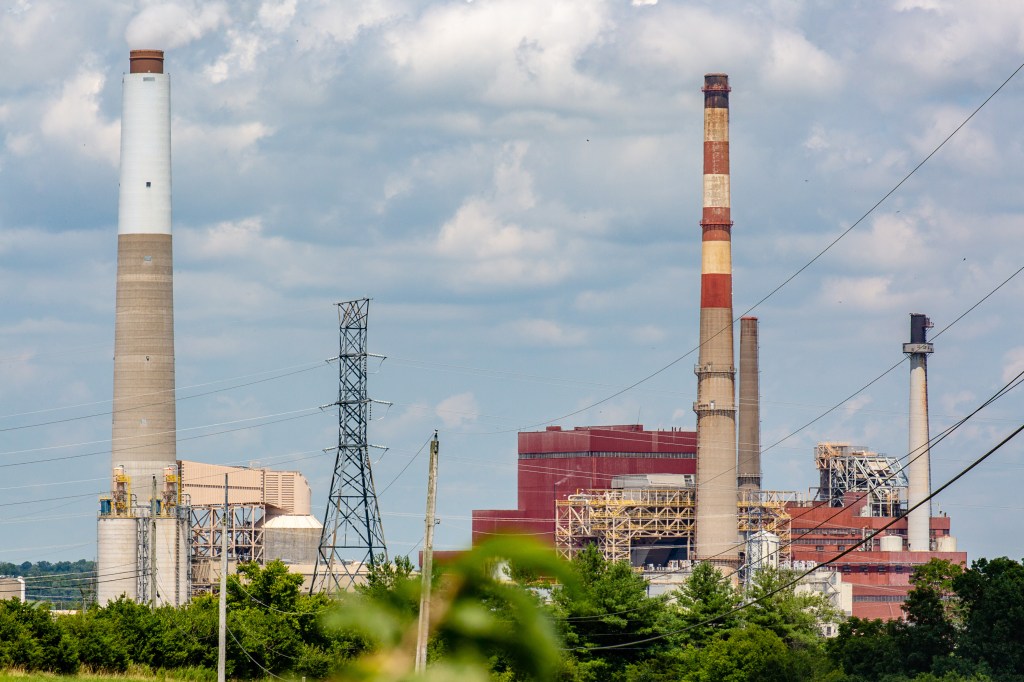Coal ash pollution confirmed in Herrington Lake, but study finds ‘no significant impacts’
Published 10:00 pm Friday, July 5, 2019

- The E.W. Brown power plant in Mercer County is seen from Curdsville Road Friday afternoon. Pollution from coal ash ponds at the plant has made its way into nearby Herrington Lake, but not in amounts that cause any significant impacts, according to a study completed last month. (Photo by Ben Kleppinger)
Conditions in Herrington Lake “do not pose an unacceptable risk to human health,” according to a study completed last month, paid for by Kentucky Utilities. But the study does list several ecological effects on the lake from selenium, found in coal ash runoff, which it says “should be monitored,” among other issues.
KU submitted a 552-page assessment, referred to as “an independent study,” to the Kentucky Energy and Environmental Cabinet for its review and approval. The study begun in 2017 was conducted by Ramboll, an international environmental consulting group, which KU hired.
It’s all part of a corrective action plan (CAP) between the state Energy Cabinet and KU, created after pollution was found near its the utility company’s Mercer County power plant, E.W. Brown Generating Station. The plan was required after a follow-up inspection of the area after the utilities had been hit with a state fine, about five years ago.
Trending
The state’s water testing found selenium levels in fish at 98 times the legally allowed limit near the plant, which is close to Dix Dam. Area groups upset about the issue circulated photos taken of a near-by inlet, showing discolored runoff water running into the lake.
KU began efforts to close its existing ash ponds at the plant, as well as to construct new treatment facilities for coal combustion materials and “an environmentally protective landfill.” KU says it has spent more than $100 million on these changes already.
However, those improvements are a result of the Environmental Protection Agency’s “more stringent … standards,” as stated by KU on its website, referring to requirements through the Safe Drinking Water Act.
The surface waters of the Dix River-Herrington Lake watershed supply drinking water for the municipal systems of Lancaster and Danville. Herrington Lake’s more than 2,000 acres are also a major recreational attraction.
Groups are worried about the existing pollution in the lake they say has already been well-studied and documented, and are suing KU in hopes of getting a clean-up commitment. Some of those documents are currently the focus of a second lawsuit, this time against the state cabinet for withholding public records concerning its study without a legal reason.
‘No significant impacts’
On June 28, the Herrington Lake Conservation League circulated an email to its members and The Advocate-Messenger, announcing the results of the study KU commissioned.
Trending
“KU’s pleased to let our Conservation League members know that the lengthy and in-depth independent study indicates its operations at E.W. Brown have had no significant impacts on the water quality or fish populations in Herrington Lake,” the release states.
The last two paragraphs describe KU’s efforts of closing its ash ponds, money spent and new treatment facilities for coal combustion, as well as “finalizing a new water treatment facility that will enhance existing controls and ensure continued environmental protection of human health and the environment. Plans and schedules for those ongoing projects have also been submitted to the cabinet.”
The conservation league is an all-volunteer, non-profit corporation “created to restore the natural beauty and improve the environmental health of Herrington Lake,” as stated on its website. The group has been credited with massive clean-up efforts of the water’s surface and 325 miles of shoreline, removing man-made debris like broken-down docks with styrofoam, and completely cleaning inlets filled with wood and other trash.
All the cleanup work is performed by an independent subcontractor, paid for by league membership dues, and the group has about 285 members right now. It works to “provide important information” to its members on topics important to the future of the lake, according to its website.
The league says it is the only entity dedicated solely to this mission, and is independent of any commercial enterprises and government agencies, managed solely by volunteer members.
“For the sake of transparency, I am a KU employee,” says Angela Zevely. She’s the environmental supervisor at E.W. Brown, who is also president of the conservation league.
She says right off the bat, “My volunteer work isn’t related in any way with what I do at the plant.”
Zevely moved to the area in 2015. “I’ve worked for corporate, and always thought this was a beautiful area. When this opening came up (with KU), I got a house on the lake.”
She explains that the conservation league is “primarily dedicated to removing man-made debris from the lake … So people don’t damage their boat or get injured, and so we have a nice view and don’t have garbage floating in the lake.”
When asked whether members are concerned about the existing pollution detected in the lake, as determined now by three studies, Zevely said of course. “Obviously, people are concerned about the quality of the lake — if it’s safe to use, swimming …”
The study shows selenium concentrations in areas of the surface water of Curds Inlet, a popular swimming and fishing hole located just below the power plant, as exceeding the Kentucky chronic water quality criterion. It lists the auxiliary coal ash pond outfall as being the “primary source identified.”
Prior to release of the KU-funded study, the utility company had disputed allegations the presence of selenium and other chemicals was due to the plant’s coal ash ponds; the company alleged the pollution could have been coming from other sources.
Selenium, arsenic and cadmium in pore water — in soil and rocks — also exceeded the criteria in areas of the inlet, according to the new study.
Concentrations of selenium and arsenic in sediment were also detected at other locations, “outside the influence of E.W. Brown,” the study says.
“The group isn’t made up of scientists … as far as quality-of-water data, things like that,” Zevely says of the league. “We really do focus on the water surface, removing styrofoam, things like that.”
The league’s mission, posted on its website, is “to preserve the natural beauty, environmental health and safety of the lake through the efforts of those who benefit, use and enjoy it.”
She says the release about the study went out to members, but she didn’t get a lot of feedback, except from one man. “He said he’d been fishing out of the lake for 40 years and eating them, and said this is what he already knew, but thanks for saying it’s safe.”
As far as Zevely working for KU and leading the league, she said if any of the league’s members had a problem with her as president, “I would step down. Last thing I’d want to do is give people the wrong impression, as far as the conservation league … They’ve done a lot of good work, and I would never want to damage their reputation.”
Zevely says in fact, Jeff Fraley, E.W. Brown’s plant manager, is also on the board of the league. “I believe he helped get it established, and Kentucky Utilities is a donor, and they contribute money to our cleanups,” she says. “KU, for lack of a better word, owns the lake.”
Herrington Lake was built by KU in 1925, created by damming the Dix River in order to generate hydroelectric power.
‘A significant contamination problem’
Attorney Ben Locke with Earthjustice, one of the organizations currently suing over lake pollution, says the lengthy study is “a lot of pages and a lot of words. We’re still reviewing it, as well.”
John Mura, executive director of the Office of Communications for the Energy and Environment Cabinet, said there is no response from the state to the study yet.
Locke says the report states the same thing now as Earthjustice did when it filed its lawsuit. “Data confirmed there’s a significant contamination problem in the inlets near the site — elevated levels of coal ash contamination in the water, sediments, fish — it’s all documented in the report.”
It also confirms the pollution is coming from contaminated ground water leaking from the power plant’s coal ash ponds. “So, essentially, KU’s study took two years to confirm what we already knew to be true,” Locke says.
Earthjustice and others concerned want KU to undertake a meaningful clean-up, and stop the ongoing flow that’s still coming from the impoundments, Locke says.
“Those contaminants are embedded in the sediment of the lake right now. A reserve of contaminants, sitting there, making their way into the food chain,” Locke says, and references the pop-eye condition and spine deformities of fish found in an earlier study.
As far as exactly what it would take to correct the entire issue, sediment and all, most have only responded it would be extremely costly.
“What would it take? That is one of the questions worth exploring,” Locke says. “(KU) could’ve been looking into that while they were fighting the responsibility.”
The study’s final section relays “recommendations and path forward,” and goes on to line out “key projects” KU has begun to in reference to controlling runoff from its auxiliary pond.
It includes that potential adverse effects to bluegill cannot be ruled out in the interior of the most affected area, Curds Inlet and that the “identification of conditions at Curds Inlet warranting evaluation of supplemental remedial actions will consider the results of the source identification.”
State still reviewing results
John Mura, director of the Office of Communications for the Energy and Environment Cabinet, said no one with the cabinet could be reached Friday for a response.
KU was asked for its response to the findings. “It was an independent study that was done,” said Lizz Pratt, KU media relations manager. She said it was submitted to the cabinet.
“We did take a look at it.”
Pratt said the company has been circulating the fact the study is now complete — and posted in its entirety on KU’s website — to area groups and residents.
When asked about the concentrations of selenium and other pollutants in the area of the inlet, Pratt said, “I want to make clear — the findings of the study did confirm the water quality meets water quality standards,” and that there is no recreational danger to using the lake.
Pratt was asked what clean-up measures would be undertaken by KU to rectify the pollution already detected; how it planned to respond to a hand-delivered petition by a local coalition demanding a meeting with KU and the cabinet; and if the company was concerned about the future of aquatic life in the inlet.
In an email, Pratt said once the cabinet has completed its review of the study, “it will be determined if any additional corrective measures are needed. This issue will be part of what we evaluate, in cooperation with the state.”
The email goes on to say, “While the study notes the presence of arsenic and selenium in the sediment, it also cites data, which is included in the report, from the U.S. Geological Survey that identifies some of the highest levels of these naturally-occurring metals are found in Central Kentucky soil.
“Just to point out again, the results of this independent study indicate our plant operations have had no significant impacts on the water quality or fish populations in the lake, and its findings confirm the water quality is safe for recreational use and meets safe drinking water standards for our community.”






